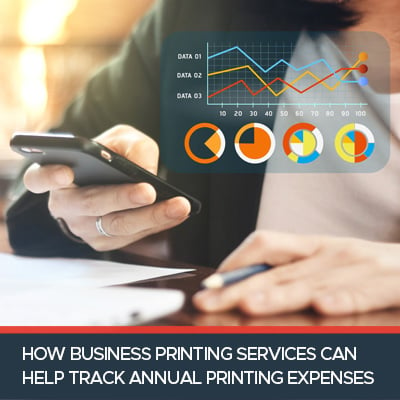How Business Printing Services Can Help Track Annual Printing Expenses

A business’s total printing costs can be up to 15% of the annual business spending. Printing is common within a business – not only does it happen all the time, but it can go almost entirely unnoticed. Unfortunately, it can lead to a drain in a company’s resources, bumping up the bottom line and eating away profits. With business printing services, companies can gain visibility of their total print costs, boost productivity, and reduce overall costs. Organizations can track their annual printing expenses with business printing services such as Managed Print Services (MPS).
The Biggest Expense Businesses Don’t Know They Have: Printing
Printing costs are one of the most underreported expenses within a business. Some features of the print environment which makes it challenging to track printing costs include:
- Poor visibility. It’s hard to keep track of who is printing, what is being printed, and what device it’s being printed from without some form of print management or tracking software. As many as 90% of businesses do not track their printing volume or printing costs.
- Printing costs are split across departments. Companies with several printers in different departments may not always think to classify printing costs as their own set of expenses, but rather bundle them into the expenditures of each department.
- Outsourced printing or supply orders go untracked. Employees may not mention when they quickly stop by print shop to get something printed, or when they pick up supplies for special projects.
- Costs go underestimated. According to the EPA, the average office worker prints 10,000 sheets of paper each year. However, a business may estimate that average at around 6,000 sheets – 40% less than reality.
How to Calculate Total Printing Costs
Calculating the total printing costs (TPC) of an office requires taking much more into consideration than only the cost of printers and toner. Gartner, a leading technology analyst firm, predicts that total printing costs are the last unmanaged business expense for a company, although it accounts for between 1 and 3% of a company’s annual revenue.
Total Printing Costs include printed documents, outsourced printing, printers, service and repairs, and supplies. Understanding and controlling the TPC is an opportunity to save 30% or more for most organizations.
To gain a sense of exactly how much is being spent on printing each year, you should understand your cost per page (CPP), as well as tally up bills associated with:
- Hardware, software, and subscription services related to the print environment
- Outsourced service and repair bills
- Supplies such as toner, paper, and specialty items for one-off projects
- Third-party printing jobs
- Utility usage, particularly electricity
- Wasted and lost documents that must be printed again
- Process costs arising from inefficiency or downtime

5 Ways Managed Printing Services Help Businesses Control Printing Expenses
Managed print services are a proven strategy for taking control of a printing environment. When deployed, they help a company in five ways.
1. Volume Monitoring and Reduction
An MPS provider can install the software necessary to monitor print volume. This is the first step for companies seeking to reduce reliance on their printers or identify precisely how much printing they are doing.
2. Budget Control
Printing volumes are rarely constant, but a managed service provider eliminates the rollercoaster of bills that might occur. By implementing a MPS program, businesses can control their TPC with a flat set monthly cost based on the data from volume monitoring – this makes it significantly easier to control a printing budget. This MPS program is priced per page with an agreement to a minimum number of prints allowing a consistent price from month-to-month.

3. Supply Inventory Management
Buying supplies for printers can prove time-consuming and expensive, especially if every device has different requirements. An MPS provider takes over supply and inventory management to ensure that the right consumables are ordered the first time around – when they are needed.
4. Increased Uptime
A dependable MPS provider will be able to create a service program that maximizes printer uptime. By engaging in proactive maintenance and leveraging things like real-time help desks, a company will enjoy more productivity as a result of well-functioning printers.
5. Less Burdened IT
Fixing printer jams is one of the most common help desk calls for an IT department, but it is not their preferred line of work. A managed service provider takes over these help desk calls to keep the in-house IT department free to pursue higher initiative tasks.
RJ Young Helps Businesses Get Their Printing Under Control
Since so many aspects of a business rely on the printers, it can be difficult to identify ways to reduce printing and its related costs. With a managed print service provider it is not only possible but a smart move for any company searching for ways to positively impact the bottom line.
Managed printing services can assist a business with taking control of its print environment. By managing supplies and maintenance, as well as making sure a business has the right printing devices, a company can enjoy a visible, streamlined, and cost-effective print environment.
RJ Young helps companies attain operational efficiency in their printing environment to reduce costs and improve productivity. Start a conversation with RJ Young today to learn what they can do for you.